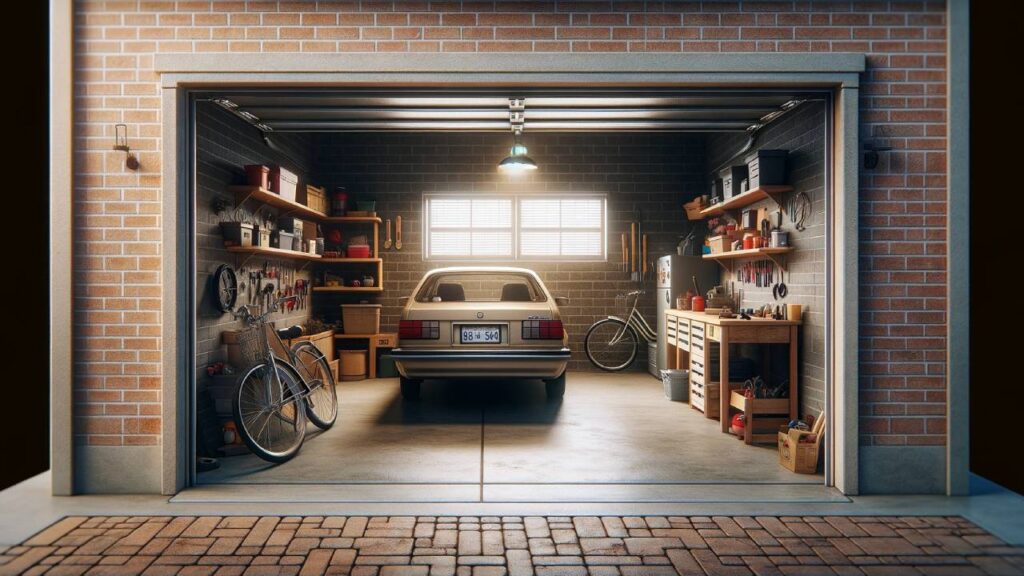As the seasons change, so do the conditions that your garage floor faces. Whether it’s a sturdy concrete surface, a sleek epoxy coating, or any other type of flooring, each season brings its own set of challenges. Understanding the importance of seasonal garage care for your garage flooring is key to preserving its functionality and appearance year-round.
During the spring, melting snow and increased rainfall can introduce more moisture and debris, potentially harming your floor’s integrity. Summer’s heat and sunlight can be tough on certain types of floors, especially epoxy coatings, which might be prone to fading or heat damage.
In fall, cooler temperatures and falling leaves bring a different set of maintenance tasks, while winter’s ice, snow, and road salt can be particularly harsh, especially on untreated concrete floors.
Each type of garage flooring, from traditional concrete to modern epoxy coatings, requires specific care as the seasons change. By tailoring your maintenance routine to address these seasonal challenges, you can protect your garage floor from weather-related wear and tear, ensuring it remains durable and visually appealing throughout the year.
This guide will walk you through the essential maintenance tips for each season, helping you keep your garage floor in top condition no matter what the weather brings.
Spring Maintenance Tips
Spring is a time of renewal, and this extends to taking care of your garage floor after the harsh winter months. Here’s how you can rejuvenate and prepare your garage floor for the warmer months ahead.
Cleaning Off Winter Residue
Start by sweeping away any debris, salt, and sand that have accumulated over the winter. These materials can be abrasive and, if left unattended, can damage the floor’s surface.
Use a mild detergent and water to mop the floor. For tougher stains, a degreaser might be necessary, especially on concrete floors.
If you have an epoxy-coated floor, be gentle. Use a soft mop and a cleaner that’s safe for epoxy. Avoid harsh chemicals that can dull the coating’s shine.
Checking for and Repairing Damage
- Concrete Floors: Look for cracks or chips in concrete floors. These can be caused by freeze-thaw cycles and should be filled or repaired to prevent further deterioration.
- Epoxy Coatings: Check for peeling or areas where the coating might have lifted. Small areas can often be patched, but larger issues may require professional attention.
- Sealant Check: Regardless of the floor type, check if the sealant is still effective. Over time, sealants can wear down, leaving your floor vulnerable to stains and moisture.
Preparing for Increased Humidity and Temperature Changes
- Moisture Control: As humidity levels rise, it’s important to ensure your garage has good ventilation to prevent moisture buildup, which can damage both concrete and epoxy floors.
- Temperature Fluctuations: Be mindful of rapid temperature changes. Concrete floors can expand and contract, potentially leading to cracks. Epoxy floors might react to extreme temperature changes, so it’s important to maintain a stable environment in your garage.
- Epoxy Floor Care: If you have an epoxy floor, spring is a good time to apply a fresh topcoat if the existing one is showing signs of wear. This not only refreshes the look of your floor but also adds an extra layer of protection.
By following these spring maintenance tips, you can ensure that your garage floor, whether it’s concrete, epoxy-coated, or another material, is clean, damage-free, and ready to face the warmer months ahead.
Summer Care Strategies
Summer brings its own set of challenges for garage flooring, with increased heat, UV exposure, and activity. Here’s how to keep your garage floor in top shape during the warmer months.
- Ventilation: Good air circulation is key to managing humidity in your garage. Use fans or keep windows open to allow air to move freely.
- Dehumidifiers: In areas with high humidity, a dehumidifier can be a valuable tool to keep moisture levels in check, protecting both concrete and epoxy floors from potential moisture damage.
- Condensation: Be mindful of condensation as it can make the surface slippery. Regularly check for any signs of moisture and wipe them away promptly.
Summer often means more foot traffic, which can bring in more dirt and debris. Sweep your garage floor regularly to prevent buildup. Quickly clean up any spills to prevent staining and potential slip hazards.
Every few weeks, give your garage floor a thorough clean. For concrete floors, a hose and a mild detergent can do the trick. For epoxy floors, use a soft mop and a gentle cleaner to avoid damaging the surface. Using floor mats in high-traffic areas can help protect the floor from wear and tear, especially in work areas or under vehicles.
Fall Preparations
As the leaves begin to turn and the air grows cooler, it’s time to prepare your garage floor for the fall season. This period often brings colder temperatures and increased moisture, which can be challenging for any garage floor. Here’s how to get your floor ready for autumn.
- Sealing and Weatherproofing: This is crucial, especially for concrete floors, to prevent moisture from seeping in and causing damage. Check the current sealant on your floor; if it’s showing signs of wear, apply a new coat. For epoxy-coated floors, ensure the coating is intact without any cracks or chips.
- Inspect for Cracks: The cooler temperatures can cause floors to contract, potentially leading to cracks. Inspect your floor thoroughly and fill any cracks you find to prevent them from worsening in the winter.
- Moisture Barriers: Consider adding moisture barriers, especially in areas where water might seep in, like near the garage door.
Fall is a great time to organize and declutter your garage. Excess clutter can trap moisture and hide issues on the floor that need attention. Ensure that all items are stored properly, preferably on shelves or in cabinets, to avoid direct contact with the floor. This is especially important for items that can leak or spill, like paints or chemicals.
Keep up with regular sweeping and mopping to prevent the buildup of leaves, dirt, and debris that can be brought in during the fall. For epoxy floors, use a soft mop and a mild cleaner to maintain the surface’s integrity.
Winterizing Your Garage Floor
Winter can be tough on garage floors with the onslaught of snow, ice, and road salt. Preparing your floor for these conditions is crucial to prevent damage and maintain its condition. Here are some strategies to effectively winterize your garage floor.
Protecting Floors from Snow, Ice, and Road Salt
- Use of Mats and Trays: Place heavy-duty mats or trays at the entrance of your garage to catch snow and ice from vehicles. This is particularly important for concrete floors, which can be damaged by salt and de-icing chemicals.
- Sealant Application: If you haven’t already sealed your concrete floor in the fall, do so before winter hits. A good-quality sealant can protect against moisture and salt damage. For epoxy-coated floors, ensure the coating is intact without any cracks.
- Salt and Chemical Clean-Up: Regularly clean any salt or de-icing chemicals that get tracked in. These can be corrosive and cause pitting or staining on both concrete and epoxy surfaces.
Insulating Tips for Temperature Management
Install or replace weather stripping around your garage door to keep cold air out. This helps in maintaining a more consistent temperature inside the garage. Consider insulating your garage walls and door. This not only helps in temperature control but also protects your floor from the stress of rapid temperature fluctuations.
If you spend a lot of time in your garage, you might want to invest in a space heater. Keeping the temperature above freezing can prevent damage to both concrete and epoxy floors.
Regular Cleaning Routines
Snow and ice can bring in a lot of debris. Regular sweeping helps to keep your floor clean and prevents abrasive materials from damaging the surface. For epoxy floors, mop with a mild detergent to remove any salt residue.
For concrete floors, a more thorough cleaning might be necessary to remove all traces of chemicals. After cleaning, make sure to dry the floor thoroughly to prevent moisture accumulation, which can lead to damage over time.
Year-Round Seasonal Garage Care Tips
Maintaining your garage floor is a year-round commitment, regardless of the type of flooring you have. Regular care not only keeps it looking great but also extends its lifespan. Here are some essential tips for maintaining your garage floor throughout the year.
Regularly sweep your garage floor to remove dust, dirt, and debris. This simple step goes a long way in maintaining the floor’s appearance and preventing scratches or stains. For deeper cleaning, mop the floor using a mild detergent and water. This is particularly important for epoxy floors to maintain their shine and finish.
Clean spills immediately to prevent stains, especially on concrete floors which are porous and can absorb liquids quickly.
Set a routine (monthly or quarterly) to inspect your garage floor for any signs of wear and tear, such as cracks, chips, or peeling. Small cracks in concrete floors can be filled with a concrete repair product to prevent them from widening.
For epoxy floors, look for signs of peeling or chipping. Minor issues can often be patched, but larger areas may require professional resurfacing. Moreover, check the condition of the floor sealant and reapply it as needed to protect the floor from moisture and stains.
Using Floor Mats and Protective Coatings
- Floor Mats: Utilize floor mats in high-traffic areas or under vehicles to protect the floor from wear, spills, and stains. They are particularly useful in work areas or spots where you might drop tools.
- Protective Coatings for Concrete: If you have a concrete floor, consider applying a protective coating, such as epoxy or polyurethane, to enhance its durability and ease of cleaning.
- Epoxy Floor Care: For existing epoxy floors, a topcoat can be reapplied every few years to renew its look and maintain its protective qualities.
Conclusion
Maintaining your garage floor throughout the changing seasons is crucial for preserving its functionality and appearance. Each season brings unique challenges, but with the right care and attention, you can protect your floor whether it’s concrete, epoxy-coated, or another material.
Whether you’re a DIY enthusiast or prefer professional care, understanding and implementing these seasonal garage care maintenance strategies will help you get the most out of your garage flooring, keeping it in top condition all year round.



